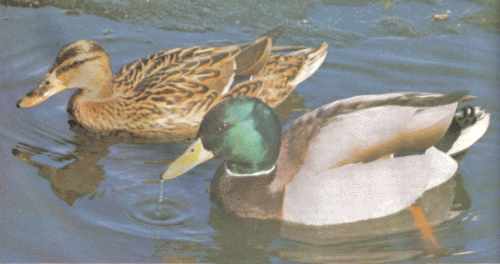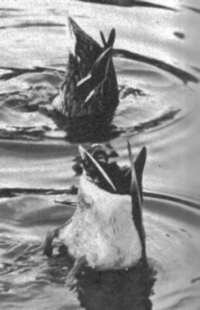 SKC Films Library SKC Films Library |
| SKC Films Library >> Science >> Zoology >> Birds >> Order Anseriformes |
| Mallard Anas platyrhynchos [ah' nuhs pla' tE rin' koz] Description The mallard may very well be the most easily recognized waterfowl in the world. The male (drake) is brightly colored from September to June. His belly and most of his back are gray. His head and neck are a dark glossy green and a white ring at the base of the neck separates the green from the brown of the breast. The female (duck) is a mottled brown. The drake moults his colorful plumage in July, and for about two months will bear a resemblance to the duck in coloration. Both sexes have wing patches which are dark or purplish-blue with white edges.
Mallards are about two feet long and weigh about 2½ pounds. Both sexes are roughly the same size. Distribution and Habitat Mallards breed in Europe and Asia from the Arctic Circle southwards to the Mediterranean, the Middle East, and Central China, and in northern and central North America. Throughout the range there is a movement south in autumn to Africa, southern Asia and, in America, to Mexico and Florida. Mallards are attracted to any water -- from a small pond in woodland to large lakes, to rivers, streams and marshes -- although they often live on dry land well away from water. Reproduction Pair bonding begins in early autumn and continues into spring. Pairing is preceded by a ritualized courtship, which is initiated by a duck swimming rapidly among a group of drakes with her neck outstretched and just above water and head nodding. This display makes the drakes come together in a tighter group and they begin their communal displays. These displays are made up of stereotyped actions known as mock drinking, false preening, shaking, grunt-whistling, head-up-tail-up and up-and-down movements. The duck chooses a drake, who follows her away from the group. She symbolically looks back by turning her head, inciting him to drive away other drakes thay may be following. The "inciting" ritual has become so ritualized within the species that it will be carried out even if no other drakes are present. The nest, built by the duck, is a shallow saucer of grass, dry leaves and feathers lined with down. It may be on the ground, usually under cover of bushes, or in the disused nest of a large bird such as a crow, or in a hollow in a tree up to forty feet from the ground. Up to 16, but usually 9 to 13, grayish, green or greenish-buff eggs are laid, from March to October. They are incubated by the duck alone for 22 to 28 days. Soon after hatching, the duck calls the ducklings off the nest and leads them to water, or, if far from water, to a feeding ground. Even when the nest is way up in a tree the ducklings leave the nest when the duck calls, each managing to tumble to the ground without injury. The ducklings are covered with yellowish down broken with large patches of brown. Fledging occurs at about two months of age. Although the drake may remain in the area after mating he takes no part in the care of the ducklings.
Diet Mallards feed by day or by night, mainly on leaves and seeds, grain, berries, acorns, as well as such small animal life as insects and their larvae, worms, tadpoles, frogs' spawn, small frogs and small fishes. They dabble in mud on land and at the edge of water, and upend in deeper water to feed from the mud at the bottom.
Other Habits and Behaviors After the breeding season, most mallards form into flocks and migrate from northern latitudes to warmer southern areas, where they wait and feed until the breeding season starts again. Some mallards, however, may stay through the winter in areas where food and shelter are abundant. The familiar quack of ducks is from the female mallard. She will give the call when she wants to bring other ducks to her. Scientific Classification phylum Chordata SOURCE |
| SKC Films Library
>> Science
>> Zoology >> Birds >> Order Anseriformes This page was last updated on June 11, 2017. |


